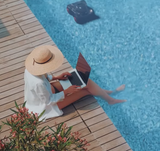As a pool owner in Nevada, I wake up every morning wondering what new challenge Mother Nature has thrown at my backyard oasis overnight. Whether it's a thick layer of wildfire ash coating the surface or discovering my water level has dropped three inches from yesterday's 115°F heat, maintaining a pool in Nevada's desert climate has become increasingly difficult. The data is sobering: Nevada has experienced a 2-degree temperature increase since 1950 , with projections showing we could face an 8-10 degree increase by century's end .
Understanding Nevada's Unique Pool Maintenance Challenges
Extreme Temperature Impact on Pool Chemistry
Nevada's status as the nation's driest state creates a perfect storm for pool maintenance issues. The intense desert heat accelerates chemical consumption, particularly chlorine, while the constant UV exposure breaks down stabilizers faster than in any other climate. Pool owners must test water chemistry two to three times per week during summer months compared to weekly testing in milder climates.
The key chemical parameters that Nevada pool owners must monitor include:
- pH levels: Maintain between 7.4-7.6 to prevent equipment corrosion
- Alkalinity: Keep at 80-120 ppm for pH stability
- Free chlorine: Maintain 1-3 ppm despite rapid UV degradation
- Calcium hardness: Monitor 200-400 ppm to prevent surface damage
Wildfire and Natural Disaster Impacts
Nevada has experienced 14 billion-dollar disaster events from 1980-2022 , with wildfires being particularly problematic for pool owners. When wildfire smoke blankets the Las Vegas Valley, ash particles settle in pools faster than traditional skimmers can handle. The National Interagency Fire Center's seasonal outlooks help predict when Nevada pool owners should prepare for increased debris loads.
Water Quality and Supply Concerns
The Southern Nevada Water Authority manages water supply for the Las Vegas metropolitan area, heavily reliant on the Colorado River. With Lake Mead water projections raising red flags , pool owners face not only quality variations but also conservation mandates. SNWA limits new residential pools to 601 square feet of surface area, emphasizing the critical need for efficient maintenance of existing pools.
Essential Seasonal Maintenance Strategies
Summer Survival Protocol (April-October)
During Nevada's brutal summer months, traditional maintenance schedules fail. Pool pumps must run 8-12 hours daily to maintain proper circulation against extreme heat. Water evaporation rates skyrocket, requiring daily level monitoring and frequent top-offs.
The iGarden K Series Solution: Nevada's extreme conditions demand automated, reliable cleaning systems. The iGarden K60 robotic pool cleaner provides up to 6 hours of continuous operation with AI-powered scheduling, ensuring your pool stays clean even during the hottest days when manual maintenance becomes dangerous. Its intelligent navigation system adapts to Nevada's unique debris patterns, from dust storms to wildfire ash.

Winter Adaptation (November-March)
While Nevada pools typically remain operational year-round, winter maintenance can be scaled back . However, neglecting winter care leads to expensive spring recoveries. Pool owners should maintain weekly maintenance tasks including skimming and basic chemical testing.

Advanced Solutions for Nevada Pool Owners
Handling Extreme Debris Loads
When Nevada's frequent dust storms or wildfire events occur, standard pool cleaning equipment simply can't cope. Pool surfaces become coated with fine particulates that traditional systems struggle to remove effectively.
The iGarden K Pro Advantage: For Nevada's most challenging cleaning situations, the iGarden K Pro Pool Cleaner delivers up to 15 hours of runtime with its Turbo 200% enhancement mode. This powerful system specifically targets the stubborn ash deposits and heavy debris loads that Nevada pool owners face during wildfire season or after dust storms.
Water Conservation Compliance
With Nevada's persistent drought conditions and Lake Mead at historically low levels , pool covers become essential. They reduce evaporation by up to 95% , but uncovered cleaning periods still require efficient maintenance systems.
Smart Technology Integration: The TurboX Master Pool Cleaner offers extended 15-hour runtime capabilities, praised by industry experts for its battery life and intelligent cleaning patterns. This extended operation means less frequent uncovering for maintenance, supporting Nevada's water conservation goals.
Professional vs. DIY Considerations
Nevada's extreme conditions make professional pool service increasingly valuable. Professional services handle chemical balancing, equipment checks, and repairs that become more complex in desert conditions. However, robotic cleaning systems bridge the gap, providing professional-level cleaning consistency without ongoing service costs.
Safety and Legal Compliance in Nevada
Nevada pool safety requirements are stringent, requiring 48-inch high barriers with self-closing, self-latching gates . Clark County emphasizes multiple protection layers , including door alarms leading to pool areas.
Proper maintenance equipment selection becomes part of safety compliance, as Nevada's extreme conditions can cause equipment failures that compromise pool safety systems.
Future-Proofing Your Nevada Pool
Climate projections show Nevada will face increasingly severe conditions. Pool owners must adapt maintenance strategies now to handle future challenges. New water planning approaches along the Colorado River will impact Nevada's water availability, making efficient pool maintenance even more critical.
The key is investing in automated, intelligent cleaning systems that can handle Nevada's unique challenges while supporting water conservation efforts. As temperatures continue rising and water becomes more scarce, pool owners who adapt their maintenance strategies now will protect their investment and continue enjoying their pools for years to come.
Conclusion: Mastering Nevada Pool Maintenance
Successfully maintaining a pool in Nevada requires understanding that traditional approaches simply don't work in our extreme desert climate. With temperatures already 2°F higher than 1950 levels and projections showing continued increases, pool owners must embrace intelligent, automated solutions that can handle wildfire ash, extreme heat, and water conservation requirements.
The combination of Nevada's rising temperatures, persistent drought conditions, and increasing natural disasters demands a proactive approach to pool maintenance. By implementing smart cleaning technology, following adapted maintenance schedules, and preparing for extreme weather events, Nevada pool owners can continue enjoying their backyard oasis despite our challenging climate.
This guide is based on official data from Nevada state agencies, climate research institutions, and professional pool maintenance standards specific to desert conditions. Regular consultation with local pool professionals and monitoring of state water authority guidelines ensures compliance with evolving regulations.



